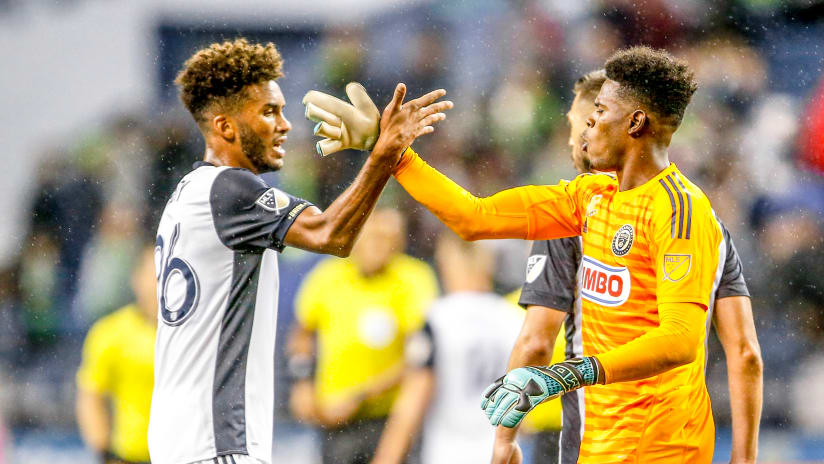Jim Curtin often talks about playing the same soccer whether Philadelphia Union are home or on the road. Philly’s brand of possession-focused play has been increasingly easy to recognize this season, with the wingers isolating fullbacks while Haris Medunjanin drops deep and the Union space the pitch and search for gaps to play into Borek Dockal’s feet. Retaining this system in Atlanta, where up to 70,000 bouncing fans make verbal communication nearly impossible, is a task that opponents rightly see as a test of the internalization of their system and the ability to execute it in the harshest of circumstances. This is exactly why New York Red Bulls’ relentless domination of Atlanta earlier this season was so impressive: Taking a system on the road is hard, and taking it to Atlanta is as hard as it gets in Major League Soccer.
Yet, over the first 20 minutes, Philadelphia Union seemed utterly unawed by the thunder of the Five Stripes’ fanbase and the whipfast talent of their attack. The sequence below provides a clear example of how Philly used organized pressure to prevent Atlanta from building out of the back. Next, the Union found Dockal and spread the field to make the Five Stripes put in work defensively. The play ends when Ray Gaddis can’t quite find CJ Sapong after Ale Bedoya opens a gap in the home side’s back line.
That’s Philly’s gameplan in motion. Moments later, Mark McKenzie nearly caught one of Atlanta’s outside center backs cheating forward on Bedoya with a gorgeous deep pass.
The most consistent theme for the Union -- both in attack and defense -- was a bold confidence in their decision-making. Haris Medunjanin played passes to Dockal with a man nearby at the top of Philly’s defensive third.
Dockal himself calmly rotated in space, picking out passes that relieved pressure even as defenders closed on him.
And Philly’s attacking trio was ascendant against Atlanta’s defensive unit, with Epps, Sapong, and Picault all unafraid to turn under pressure and take on their opponents.
Defensively, Philly’s high line meant they remained compact in the center of the pitch and prevented Miguel Almiron and Ezequiel Barco from collecting the ball with room to run.
Atlanta’s outside center backs would carry play forward but end up selecting secondary, less dangerous passing options.
Of course, Atlanta is still Atlanta, and their true secret weapon is head coach Tata Martino. So any Union mistakes in midfield became five alarm fires in a hurry.
In the clip above, Dockal’s turnover appears to be safely cleared by Gaddis, but Atlanta has playmakers all over the pitch. Gonzalez Pirez collects the loose ball -- at nearly a full sprint, no less -- and leads Almiron and Josef Martinez on an immediate breakout. Mark McKenzie does incredibly well to read Almiron’s attempt to draw the defense to the right, and he stays in the lane to Martinez to intercept.
Sudden changes
Of course, everything changed in the 19th minute. McKenzie’s mistake led to a penalty call, and moments later Bedoya and Medunjanin were ejected.
But to their credit, the Union were unphased by Atlanta’s two-man and one goal advantages. They stuck to their key defensive principles: Compactness and protection of the center. Curtin inserted Warren Creavalle for Dockal, and the hard running defensive midfielder put on a clinic.

This is Warren Creavalle, only midfielder on the pitch for Philadelphia, making a tackle and three recoveries in Atlanta’s half. Creavalle could not simply focus on his own zone because, again, he was the only midfielder on the pitch. So there was Creavalle, not even part of the first eleven and playing in front of a teenaged center back pairing, and organizing his wingers-turned-midfield-partners in one of the league’s loudest stadiums.
Check out Atlanta’s pass map from the first half after going up two men.

Almost nothing in the middle. With MLS’ most expensive attack. With two extra men. At home.
Atlanta makes adjustments, Union keep working
After 20 minutes of frustration, Martino threw on Mikey Ambrose at left wingback after halftime. The substitution had a clear purpose: Pin Philly’s defensive line back so Almiron could drop into space to receive the ball without coming too deep.
Additionally, the Union’s good defensive work in the first forty-five had turned Atlanta into a bully: They were so determined to prove they could beat Philly by working through Almiron and Barco up the left that they abandoned the right side of the field entirely (see the image above).
The second half saw a more patient and balanced Atlanta attack. But even so, the Union made it extremely difficult to create good opportunities: Only two shots on frame from inside the box, and very few from the center of the box.
In other words, this was the movie 300 as interpreted through soccer. The Union were vastly outnumbered, but they never considered giving up.
Curtin said that his team was a bit disappointed in their performance midweek against Chicago despite winning 3-1. Three days later, the players that remained on the field after going down two men made certain that Jim Curtin could go to the post-match podium and speak not of disappointment, but of pride.













